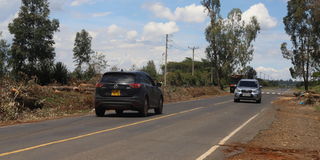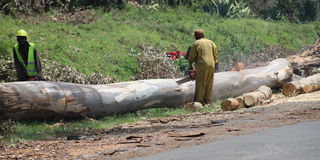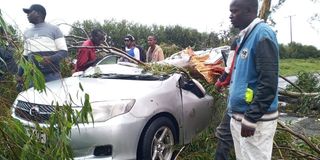Moi-era trees fall leaving behind memories for Kabarak residents

A section of Kabarak road along Eldama Ravine route, from Mangu junction, after trees were cut down. Photo taken on April 15,2025.
Kabarak Road, particularly along Eldama Ravine route, has long been celebrated for its lush green canopy formed by rows of mature trees that lined the road.
These trees created a picturesque corridor offering travellers not just beauty but a refreshing atmosphere characterized by cool breezes and clean air.
For many, the route has held sentimental value, a scenic memory etched in their mind. However, this iconic view is disappearing rapidly as a wave of tree felling transforms the landscape, leaving previously shaded areas barren.
The tree cutting, beginning at Mangu Junction, has seen a large section of the tree line cleared. Towering trees that once provided shade and wind protection now lie as logs, waiting for transport.

Workers using chain power saws to cut the felled trees into sizable chunks that can be transported on April 15,2025 along the Eldama Ravine road.
This shift has prompted concerns and emotions among local residents who feel a deep connection to the trees, not just for their aesthetic or environmental benefits but also because of their personal histories with them.
Irene Njeri, born and raised in Kampi ya Moto, recalls that the trees were originally planted by schoolchildren during a tree-planting project under President Daniel Arap Moi’s administration early 1992.
As a class six student at the time, she participated in the initiative, walking long distances from school to plant the seedlings.
The effort went beyond planting; students took active roles in caring for the young trees. Njeri remembers carrying five-litre jerricans to water the trees during dry seasons, chaperoned by their teachers.
These trees, she emphasizes, were nurtured with dedication and love by the children of that era.
For residents like Rotich*, a lifelong resident of the area, the trees are part of the community’s identity. He has even collected and planted the trees’ seedlings at his home in Baringo. Rotich also adds on the practical importance of the trees.
"Many commuters travel on foot, and the shade provided by the tree canopy was vital for comfort during hot days. Additionally, the trees served well for farmers since they acted as windbreaks that protected staple crops like maize and wheat from damage," he notes
The reason behind the sudden cutting of trees, however, stems from a tragic event.

A photo of the car after a tree fell on it while on transit along kabarak road. This resulted in a death at the Mangu Junction .
Heavy rains recently caused a tree to fall on a moving car, resulting in a fatality. Other branches also collapsed onto the road, leading to traffic delays and alarm among road users.
Simon, a boda boda operator who witnessed the incident, describes how the event created widespread panic. Following this, officials from the Kenya National Highways Authority (KeNHA) visited the site, after which the cutting of trees close to the road began.
KeNHA has however clarified that they are not directly involved in the tree cutting.
According to Kariuki Thuku, a Senior Corporate Communications Officer at KeNHA, Kabarak University is overseeing the process, stating that there is an agreement in place that for every tree removed, a new one will be planted at a safer distance from the road.
While the safety measures may be justified, they have ignited debate among residents and environmentalists.
James Wakibia, a known environmental advocate, acknowledges the emotional value of the trees but insists that protecting human life must take precedence.
He concedes that trees can be replanted, but a lost life cannot be restored.


